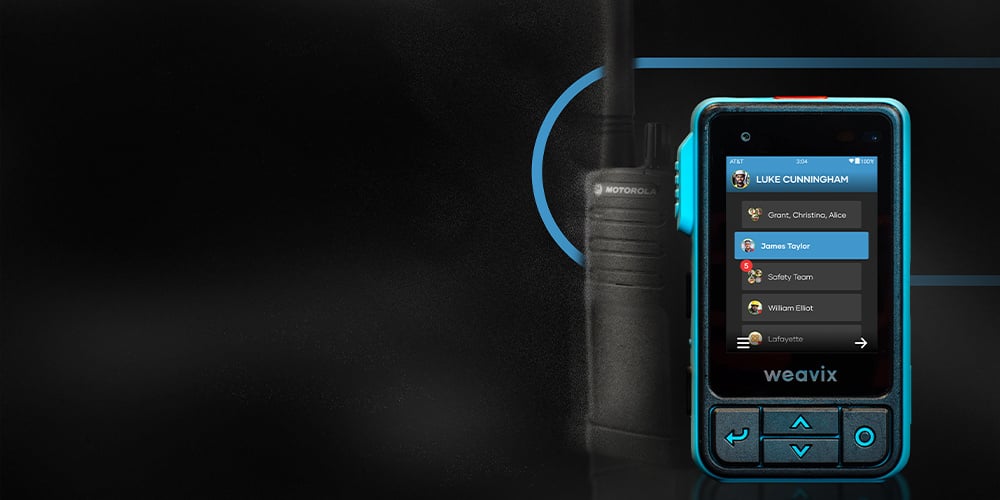Communication technology hasn’t stopped evolving since the beginning of… technology. Analog and digital radio systems have become essential tools for seamless communication across almost every industry.
But as workplace communication demands grow, the debate continues: Which is better when comparing digital vs analog radio systems? And how do smart radios take frontline communication to the next level? Let’s dive in.
What Is an Analog Radio?
An analog radio is a radio system that transmits and receives continuous waves that carry analog signals. This pioneering communication technology has long supported frontline teams through professional two-way radio systems, walkie-talkies for short-range use, and paging systems.
Here’s how it works:
- Signal transmission: Analog radio systems transmit audio in the natural form and then broadcast it using electromagnetic waves
- User experience: They are simple to use and have been staples in industries like construction and public safety for decades
- Drawbacks: Analog systems struggle with interference, limited range, high costs, and the lack of modern features
Despite their simplicity, the limitations of analog two-way radios often push users to consider modern alternatives.
What Is a Digital Radio?
A digital radio is a system that uses digital signals to transmit audio and data over radio waves. The result? Clear, more efficient communication.
Digital radio systems typically offer:
- Crystal-clear audio: These radio systems reduce background noise and interference so messages are delivered accurately
- Additional features: They usually use functionalities like text messaging and GPS tracking
- Energy efficiency: They drain less battery power compared to analog devices
Digital two-way radios are essential for industries that require higher communication standards, like manufacturing, but they also have limitations, particularly in terms of initial cost and complexity.
What's the Difference Between Digital and Analog Radio Systems?
The difference between digital and analog radio systems goes beyond just the type of signal they use. These systems differ in transmitting, processing, and decoding audio, so digital solutions often deliver more precise sound and better overall performance.
Let’s compare digital vs analog radio systems to understand their strengths and limitations better.
|
Feature |
Analog Radio System |
Digital Radio System |
|
Audio Quality |
Prone to static and interference |
Clear audio with minimal noise |
|
Range |
Limited range with signal loss |
Consistent signal over a more extended range |
|
Features |
Basic voice communication |
Basic voice communication and features like text messaging, GPS tracking, and encryption |
|
Battery Life |
Moderate |
Efficient with extended battery life |
|
Cost |
Lower upfront cost |
Higher initial investment |
Analog vs Digital Radio Communication: Which One Is Better?
Choosing between digital and analog radios depends on many factors, including your unique needs and requirements. For example, manufacturers prefer PTT radios because of their durability and reliability, but analog systems typically lack clear audio quality, which is crucial in noisy workspaces. Here’s a quick guide to finding the right radio solution:
When to choose analog radios:
- Costs need to stay low: If price is a major concern, analog radios are more affordable upfront
- Simplicity is key: Analog radio communication systems are ideal for straightforward voice communication without the need for advanced features
- Teams are small: For smaller frontlines or teams operating within a very limited range, analog can be enough
When to choose digital radios:
- You need more features: Digital systems excel where basic features like GPS and text messaging are essential
- More extensive coverage is necessary: Industries needing communication reach farther, such as oil and gas, should consider digital systems
- Scalability is a must: For growing and changing organizations requiring more channels, digital radios offer more flexibility
Both radio systems have their drawbacks, particularly when compared to newer, more advanced communication solutions that revolutionize workplace comms.
Why Smart Radios Outperform Analog and Digital Radio Systems
Smart industrial radios are designed to greatly surpass the limitations of traditional analog and digital systems while introducing a new standard for the frontline. Here’s why they stand out:
1. Breakthrough Features
Smart radios are equipped with advanced features like:
- AI-powered language translation: Uses artificial intelligence to automatically translate spoken or written language in real-time, facilitating communication in the frontline
- Dictation and text-to-speech capabilities: Converts spoken words into written text or reads aloud written text, enhancing accessibility and convenience
- Message playback: Users can replay voice messages or audio content, ensuring they easily review and understand important information
These features make communication seamless across diverse teams, eliminating language barriers and boosting productivity.
2. Superior Connectivity
Unlike analog and digital radios, which are limited by range and infrastructure, smart radios operate globally using Wi-Fi and LTE networks. Unlimited range is a critical difference between legacy and smart radios — traditional solutions don’t work everywhere they’re needed. Smart devices offer full connectivity, eliminating dead zones and the ability to connect teams around the world.
3. Endless Scalability
Smart radios feature unlimited channels, letting organizations scale communication without investing in additional hardware. From teams of 10 or 10,000, this flexibility transforms your network into a robust digital communication platform that grows with your needs.
4. Enhanced Safety Capabilities
With built-in safety solutions like mass alerts, a man-down button, and muster tracking, smart radios help protect workers in any environment. That means teams can respond quickly in emergencies, improving workplace safety and employee confidence.
5. Integration with Other Devices
Smart radios seamlessly integrate with other tools and systems like connected worker platforms. This helps teams streamline workflows, analyze data, and improve decision-making.
Go Beyond Analog and Digital Radio Systems with walt
Digital vs analog radios represent the past. walt Smart Radio is undoubtedly the present and the future. Powered by the weavix platform, walt combines adaptable technology with user-friendly functionality to redefine communication for the modern frontline.
Why choose walt?
- Safety: Gain mass alerts, a dedicated man-down button, and safety reporting to keep frontline workers safe
- Unlimited channel creation: Enable seamless connections across any group size with endless 1-1 and group channels
- Global coverage: Connect anywhere, anytime with Wi-Fi and LTE
- AI-driven insights: Leverage data analytics and AI for better operational insight
- Future-proof: Stay ahead with a device designed to evolve as you do
The transition from analog to digital radio systems marked a massive milestone in communication tech. Introducing smart radios has bridged the gap between functionality, safety, and scalability. Devices like walt are not just tools — they’re a rocket ship of efficiency, collaboration, and innovation.
To learn more about how walt and the weavix platform can transform your communication strategy, book a demo today.
Subscribe
Don’t miss out on industry news and information. Subscribe to interweave, the official weavix™ blog today.



